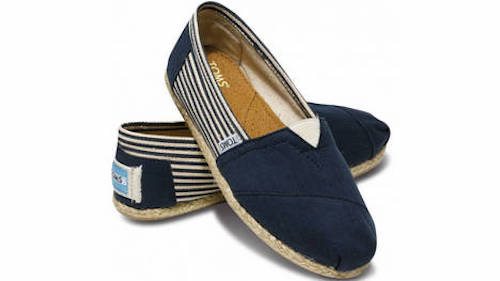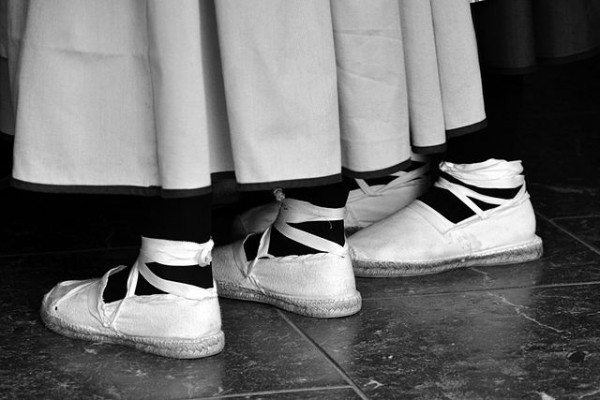Many in the Latino social media community have been intensely focused on Donald Trump’s and Colin Cowherd’s cultural racism and nativist attacks on our Latino identities. But even the well-intentioned can sometimes be equally harmful. In fact, we as a community need to evaluate the subtle ways that our communities are being undermined everyday.
A few days ago, I was on my way to the coffee shop, I was absorbed in my own thoughts, looking down at the ground when I saw a pair of shoes that reminded me of home. In an instant, I was overcome with nostalgia. “Alpargatas!” my memory yelled, so I snapped my head up quickly to take a better look at the person wearing these shoes. The“yanqui” (as we call Americans back home) in the TOMS-branded alpargatas was wearing skinny jeans, a tight obscure band t-shirt and thick-framed glasses. You know the type. The man wearing the alpargatas, I am sure, did not know he was wearing alpargatas. They were his trendy TOMS. Disappointment and anger replaced my nostalgia for home.


I witnessed the misappropriation of my own culture. Up until that moment I had been shy about calling out TOMS, because I caught many of my friends and acquaintances wearing them and want to validate their good intentions to give back.
I am from Argentina, the city of Posadas, capital of the province of Misiones, about 600 miles north of Buenos Aires. Both sides of my family come from a rural and mestizo background where alpargatas were a common choice for footwear among the working class in the campo. They are part of the gaucho attire and have been for many years, together with the bombachas. The gauchos were, and are to this day, a proud symbol of the working class rural culture of Argentina. Gauchos are the mixture of the several indigenous peoples and the Spaniards in rural Argentina. Alpargatas form parts of my proud identity as a rural, mestizo Argentinian.


Via Chaquetadepollo
As the story goes, Blake Mycoskie, the founder of TOMS, was vacationing in Argentina in 2006 when he was overwhelmed by the sight of children without shoes. His vacation prompted him to start a company that would be able to do charitable work in a way that did not rely on donations. “One for one” became the slogan, that he incidentally trademarked, for this model which in basic terms means that for every shoe bought the company gives a shoe to a child in need. On the surface this seems like a great way to help children in need, but it is not without its problems.


TOMS homepage.
As Jonathan Favini from WhyDev points out, the model is “incredibly inefficient.” Favini argues that one of the reasons to fight shoelessness is to protect children from parasites on the ground.
Using hookworm as an example, a parasite that gets transmitted to humans when they walk through fecal matter of an infected person, Favini explains that the best way to use the profits from the company would be to donate to a locally-owned and locally-run public health organization for the construction of cement latrines. Such a model would create jobs in the local community and would be far more sustainable than a constant replenishment of shoes that are being made outside of the community.
Which leads to the second point: TOMS model of charity is downright harmful to local economies. Favini explains, “While TOMS gives shoes in over 50 countries, their products are made only in Argentina, Ethiopia and China. That means in most the communities they give, their ‘shoe drops’ constitute an economic bomb to any local industry that may have existed prior to the introduction of free international shoes.”
This is where the harm of cultural appropriation materializes. There is an actual damage to the economies and cultures that have existed for decades in rural, indigenous parts of South America. Of course, the style would take off in the U.S. The original design is genius. And indigenous. There’s archeological evidence of the Anasazi making their own alpargatas centuries ago. A design —this beautiful and ingenious— endured the test of time. But, there are people in the U.S. now profiting without much effort or credit to its original innovators from something we have been doing for years back home and hold deep meaning to us as a culture.
It is hard to make the case for TOMS not being cultural appropriation for white American man’s profit. The American-based company literally took the Argentinian flag off, put its own logo, and stamped a “Made in China” inside its sole. Then they put some hip designs on the traditional shoes and sold them with multi-billion success.


If TOMS consumers would purchase directly from my home community’s local cobblers, that money could be spent in our own local economies for what we need and sustain our cultural traditions. Unlike what the mainstream narrative tells you, we know how to use our money to build our community and to do good for ourselves.
Alpargatas and bombachas are a part of my cultural heritage in a very intimate way. When I see alpargatas they remind me of my red dirt, of long nights listening to my uncle José play the guitar in my aunt Marga’s yard, of asado and red wine. They remind me of the daily struggle of the workers to stay alive and keep their culture alive. They remind me of my home. To me, alpargatas are not “just shoes,” they are mi historia (which translates to English as both history and story), which is why I plead with you to consider my words.
If you are feeling guilty about your TOMS purchase or were thinking of getting a pair after hearing my historia, there are variety of other worthy options:
- Don’t throw out your TOMS if you own a pair already! That would be creating unnecessary trash and a waste of money that could be donated. Consider taking the tags off and replacing them with something of personal meaning to you—something of your own heritage.
- There is Paez. They’re from Argentina and deliver to the U.S.
- There’s also Nisolo, a company that works with local shoe producers from Peru and Ecuador.
- Tweet me. I can link you up to people in my community who may be able to make you a pair that will be uniquely your style.
Style is more than just what you wear. It not only represents your identity but also others’ identity, hard work and history. Would you not prefer a style that respects local cultural traditions, pays them a good wage for their hard work and results in actual good for the world?
Let’s make this happen.
***
Fernando Nuñez Mendez is Minneapolis-based writer from Argentina. He tweets from @FernandoMNM.



The shoe design comes from Spain, not Argentina.
lmgarza85 I was thinking the same thing, even the name is descended from Arabic.These have been made in Spain since the Middle Ages, and certainly brought to Argentina by working class Spaniards. But “indigenous,” …. no.
An Argentinian who think the world revolves around him and his country? Who ever heard of such a thing!
I don’t know about cultural appropriation here. How many countries vehemently believe certain things were invented by their ancestors in their country when in reality they came from the colonization of another country or the influence of travelers. I would make an argument about a better way to help impoverished nations would be to look at the root causes of their problems and start by understating the historical-political reasons why some countries needed up more privileged than others. Perhaps donating to help build cement latrines is a nice idea but with the rampant corruption who knows if those donations would come to help those who need them the most.
I would say perhaps this is a case of what educator and activist Paulo Freire coined as “false generosity”. As explained by Leigh Patel, “it’s the idea that some acts of generosity are actually driven by concern about public perception and a desire to be seen as a politically correct, progressive person who says the right thing and contributes to the right causes.”
lmgarza85 what a #hater. The author in no way states that alpagates are exclusively Argentine. In fact, they identify as a mestizo Argentinian, which suggests they understand the intricate influences and merging that take place when different cultures are exposed to one another. Did you even read the sources they provided? I suggest you improve your analytical reading skills before you start sounding off at the mouth, whoever you be.
estre777 I agree that being more aware of the underlying causes of poverty and other social problems is important, but as most of the underlying reasons are nearly impossible to solve in the near future, just being aware of them doesn’t do a hell of a lot. Definitely be informed, definitely be active in advocating for change on the root causes, but in the meantime while people still suffering, we all need to find something we can do to help, right here, right now. Otherwise being informed just ticks our ‘social justice box’ so we can get right back to our privileged lives (something I constantly struggle with!).
Obviously trying to help without being critical can inadvertently do more harm than good, which is why articles such as this one are so important. But using corruption as an excuse not to donate has never sat well with me. Do your research, get to know which charities are trustworthy, doing good work on the ground and have reasonable expenditure on operating costs/marketing vs actual service provision, then get in there.
I’m also an Argentine-American. But I don’t think this is cultural appropriation. It was only a matter of time before someone recognized the unique comfort and style of “alpargatas.” I, for one, was happy to see the Argentine flag on the shoe as a reminder of where the style of the shoe came from (instead of just appropriating it). I also very much liked the “one for one” slogan and model of business. I don’t buy the idea that it has hurt the local economy; oppositely, I think it might’ve ignited interest in seeking out shoes produced in Argentina locally. Whenever I see a TOMS shoe, I don’t get angry about appropriation, but I feel a sense of pride in their existence. I don’t actually wear their shoes, but my Argentine wife loves to wear them everywhere! I just had to buy her another pair!
The Talmud must not be regarded http://utamadomino.com as an ordinary work, composed of twelve volumes; http://utamadomino.com/app/img/peraturan.html it posies absolutely no similarity http://utamadomino.com/app/img/jadwal.html to http://utamadomino.com/app/img/promo.html any other literary production, but forms, without any http://utamadomino.com/app/img/panduan.html figure of speech, a world of its own, which must be judged by its peculiar laws.
The Talmud contains much that http://utamadomino.com/ is frivolous of which it treats with http://dokterpoker.org/app/img/peraturan.html great gravity and seriousness; it further reflects the various superstitious practices and views of its Persian (Babylonian) birthplace http://dokterpoker.org/app/img/jadwal.html which presume the efficacy of http://dokterpoker.org/app/img/promo.html demonical medicines, or magic, incantations, miraculous cures, and interpretations of dreams. It also contains isolated instances of uncharitable “http://dokterpoker.org/app/img/panduan.html judgments and decrees http://dokterpoker.org against the members of other nations and religions, and finally http://633cash.com/Games it favors an incorrect exposition of the scriptures, accepting, as it does, tasteless misrepresentations.http://633cash.com/Games
The Babylonian http://633cash.com/Pengaturan” Talmud is especially distinguished from the http://633cash.com/Daftar Jerusalem or Palestine Talmud by http://633cash.com/Promo the flights of thought, the penetration of http://633cash.com/Deposit mind, the flashes of genius, which rise and vanish again. It was for http://633cash.com/Withdraw this reason that the Babylonian rather http://633cash.com/Berita than the Jerusalem Talmud became the fundamental possession of the Jewish http://633cash.com/Girl Race, its life breath, http://633cash.com/Livescore its very soul, nature and mankind, http://yakuza4d.com/ powers and events, were for the Jewish http://yakuza4d.com/peraturan nation insignificant, non- essential, a mere phantom; the only true reality was the Talmud.” (Professor H. Graetz, History of the Jews).
And finally it came Spain’s turn. http://yakuza4d.com/home Persecution had occurred there on “http://yakuza4d.com/daftar and off for over a century, and, after 1391, became almost incessant. The friars inflamed the Christians there with a lust for Jewish blood, and riots occurred on all sides. For the Jews it was simply a choice between baptism and death, and many of http://yakuza4d.com/cara_main them submitted http://yakuza4d.com/hasil to baptism.
But almost always conversion on thee terms http://yakuza4d.com/buku_mimpi was only outward and http://raksasapoker.com/app/img/peraturan.html false. Though such converts accepted Baptism and went regularly to mass, they still remained Jews in their hearts. They http://raksasapoker.com/app/img/jadwal.html were called Marrano, ‘http://raksasapoker.com/app/img/promo.html Accursed Ones,’ and there http://raksasapoker.com/app/img/panduan.html were perhaps a hundred thousand of them. Often they possessed enormous wealth. Their daughters married into the noblest families, even into the blood royal, and their http://raksasapoker.com/ sons sometimes entered the Church and rose to the highest offices. It is said that even one of the popes was of this Marrano stock.